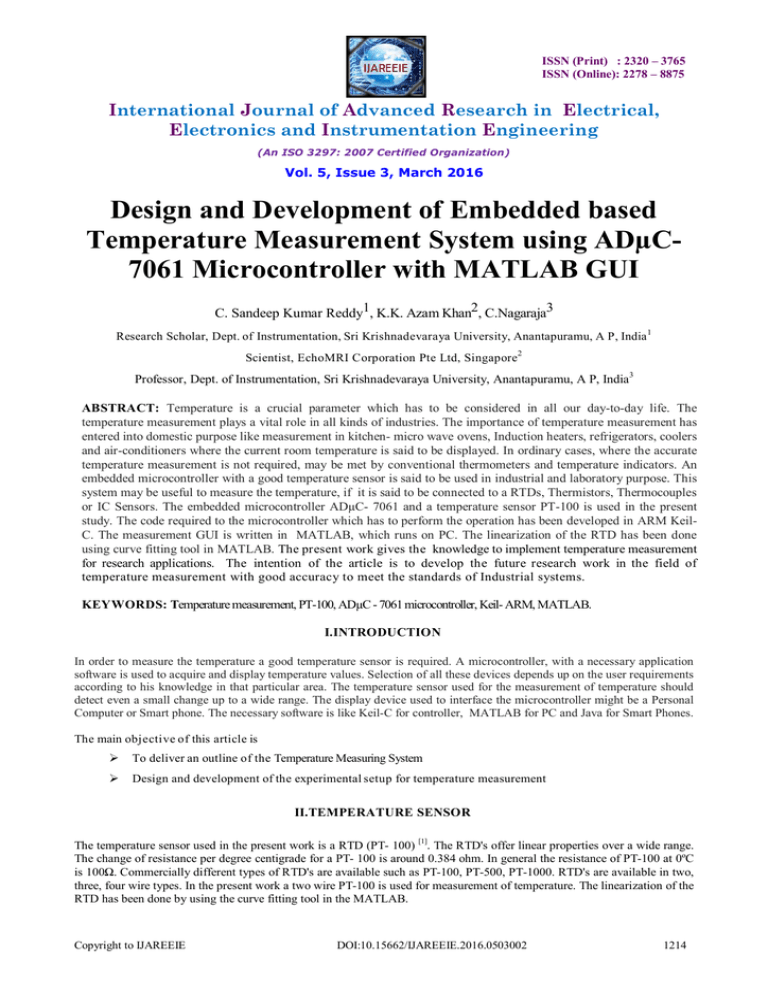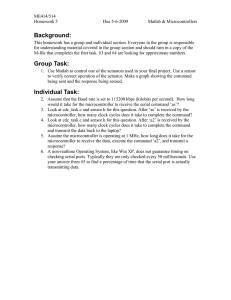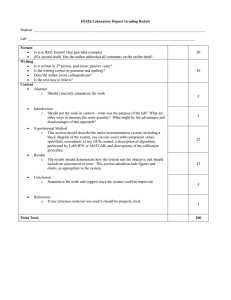Design and Development of Embedded based Temperature
advertisement

ISSN (Print) : 2320 – 3765 ISSN (Online): 2278 – 8875 International Journal of Advanced Research in Electrical, Electronics and Instrumentation Engineering (An ISO 3297: 2007 Certified Organization) Vol. 5, Issue 3, March 2016 Design and Development of Embedded based Temperature Measurement System using ADµC7061 Microcontroller with MATLAB GUI C. Sandeep Kumar Reddy1, K.K. Azam Khan2, C.Nagaraja3 Research Scholar, Dept. of Instrumentation, Sri Krishnadevaraya University, Anantapuramu, A P, India 1 Scientist, EchoMRI Corporation Pte Ltd, Singapore2 Professor, Dept. of Instrumentation, Sri Krishnadevaraya University, Anantapuramu, A P, India3 ABSTRACT: Temperature is a crucial parameter which has to be considered in all our day-to-day life. The temperature measurement plays a vital role in all kinds of industries. The importance of temperature measurement has entered into domestic purpose like measurement in kitchen- micro wave ovens, Induction heaters, refrigerators, coolers and air-conditioners where the current room temperature is said to be displayed. In ordinary cases, where the accurate temperature measurement is not required, may be met by conventional thermometers and temperature indicators. An embedded microcontroller with a good temperature sensor is said to be used in industrial and laboratory purpose. This system may be useful to measure the temperature, if it is said to be connected to a RTDs, Thermistors, Thermocouples or IC Sensors. The embedded microcontroller ADµC- 7061 and a temperature sensor PT-100 is used in the present study. The code required to the microcontroller which has to perform the operation has been developed in ARM KeilC. The measurement GUI is written in MATLAB, which runs on PC. The linearization of the RTD has been done using curve fitting tool in MATLAB. The present work gives the knowledge to implement temperature measurement for research applications. The intention of the article is to develop the future research work in the field of temperature measurement with good accuracy to meet the standards of Industrial systems. KEYWORDS: Temperature measurement, PT-100, ADµC - 7061 microcontroller, Keil- ARM, MATLAB. I.INTRODUCTION In order to measure the temperature a good temperature sensor is required. A microcontroller, with a necessary application software is used to acquire and display temperature values. Selection of all these devices depends up on the user requirements according to his knowledge in that particular area. The temperature sensor used for the measurement of temperature should detect even a small change up to a wide range. The display device used to interface the microcontroller might be a Personal Computer or Smart phone. The necessary software is like Keil-C for controller, MATLAB for PC and Java for Smart Phones. The main objective of this article is To deliver an outline of the Temperature Measuring System Design and development of the experimental setup for temperature measurement II.TEMPERATURE SENSOR The temperature sensor used in the present work is a RTD (PT- 100) [1]. The RTD's offer linear properties over a wide range. The change of resistance per degree centigrade for a PT- 100 is around 0.384 ohm. In general the resistance of PT-100 at 0ºC is 100Ω. Commercially different types of RTD's are available such as PT-100, PT-500, PT-1000. RTD's are available in two, three, four wire types. In the present work a two wire PT-100 is used for measurement of temperature. The linearization of the RTD has been done by using the curve fitting tool in the MATLAB. Copyright to IJAREEIE DOI:10.15662/IJAREEIE.2016.0503002 1214 ISSN (Print) : 2320 – 3765 ISSN (Online): 2278 – 8875 International Journal of Advanced Research in Electrical, Electronics and Instrumentation Engineering (An ISO 3297: 2007 Certified Organization) Vol. 5, Issue 3, March 2016 The relationship between the RTD’s resistance and temperature in degree centigrade is earlier described by the CallendarVan Dusen equation, RRTD = R0[1 + AT + BT2 + C(T – 100)T3], whose values are defined as follows: R0 is a 100Ω at 0°C (PT-100) A = 3.9083 × 10–3 B = –5.775 × 10–7 C = 0 for T > 0°C, or C = –4.23225 × 10–12 for T < 0°C. A. Different Types of Curve Fitting tools for RTD: The procedure for curve fitting in MATLAB is as follows. In the present article, the PT 100 data (Resistance Vs Temperature) is placed in a spread sheet (Microsoft Excel format). Open MATLAB, type "cftool" in command window. The Excel file has to be placed into the Matlab working directory. Import the data from the file and plot the XY graph. Figure window is now displayed on the screen select <Tools> from main menu and <Basic fitting> in the sub menu. Now Basic fitting window is displayed on the screen as shown in Figure 1. Choose <check to display fits on figure>. Select the appropriate type of fitting required. Tick the option <show equations and norms of residuals>. The plotted graph for the selected variables may be displayed as shown in Figure 2. Figure: 1 Basic Curve Fitting Window in MATLAB GUI Copyright to IJAREEIE DOI:10.15662/IJAREEIE.2016.0503002 1215 ISSN (Print) : 2320 – 3765 ISSN (Online): 2278 – 8875 International Journal of Advanced Research in Electrical, Electronics and Instrumentation Engineering (An ISO 3297: 2007 Certified Organization) Vol. 5, Issue 3, March 2016 Figure: 2 Graph plotted for Resistance Vs Temperature By observing the Table 1 it is clear that the equation for curve fitting remains same for both the Temperatures <0 and the Temperatures >0 but, the coefficients and norm of residuals may varies. The table gives the values of coefficients required for different types of fitting. Table: 1 Equations with coefficients for various types of fit S.No Type of Fit p1 Equation y = p1*x + p2 T<0 T>0 2.4585 2.9221 p2 -247.26 Coefficients 1 Linear Norm of residuals Coefficients 2 3 Quadratic p1 p2 p3 Norm of residuals Cubic p1 p2 Copyright to IJAREEIE -311.69 3.6724 86.305 y = p1*x^2 + p2*x +p3 T<0 T>0 0.001473 2.2833 -242.94 0.30985 0.0014418 2.2074 -233.54 6.3652 y = p1*x^3 + p2*x^2 +p3*x + p4 Coefficients T<0 T>0 -5.76E-06 1.43E-06 0.0024987 0.0003862 DOI:10.15662/IJAREEIE.2016.0503002 x value of RTD resistance in ohms x value of RTD resistance in ohms x value of RTD resistance in 1216 ISSN (Print) : 2320 – 3765 ISSN (Online): 2278 – 8875 International Journal of Advanced Research in Electrical, Electronics and Instrumentation Engineering (An ISO 3297: 2007 Certified Organization) Vol. 5, Issue 3, March 2016 p3 p4 Norm of residuals 2.2287 -242.11 ohms 2.4494 -250.39 0.039382 0.60062 y = p1*x^4 + p2*x^3 +p3*x^2 + p4*x +p5 Coefficients T<0 T>0 4 4th Degree Polynomial p1 p2 p3 p4 p5 Norm of residuals 1.86E-08 -1.02E-05 0.0028632 2.2166 -241.98 0.033286 1.81E-09 -3.55E-07 0.0010107 2.3579 -245.7 0.088045 x value of RTD resistance in ohms III. EMBEDDED MICROCONTROLLER ADµC 7061 MINI KIT A. Salient Features of Eval ADµC-7061MKZ Microcontroller Board: The Microcontroller board meets the requirements of the user who wish to measure the temperature with good accuracy. The specifications of the Microcontroller board are listed below [3]. o ARM 7 RISC Microcontroller o Dual 24 Bit Sigma -Delta Analog to Digital Converter o 2 differential input or 5 single ended channels o Programmable ADC output rate from (4 Hz to 8 KHz) o Programmable current excitation source for RTD's from 200 µA to 2 mA o Programmable gain Amplifier from 1-512 in input stage o Communication Interfaces like SPI, UART o on board SMD RTD for direct measurement of ambient temperature measurement B. Algorithm: The algorithm to measure temperature, which is implemented in Keil- ARM C as follows [3]. Initialize the Microcontroller board and UART for 9600 baud. Excite the current source IEXC0 to 400 µA (user defined ) IEXC0 Fix the gain of internal PGA value so that the desired range of measured value should not cross the full scale voltage of ADC which is 1.2 Volts. In the present work the gain is set to 16 The Resistance value of the RTD is computed, which is given by the manufacturer in an example code, Remove the on board SMD RTD so that the external temperature sensors can be connected Connect the two wire PT-100 to the Pin No's: 11 and 17 of the microcontroller board as shown in Figure 3 In the present measurement system the quadratic fit is implemented and the co-efficients are used to compute temperature reading. Figure 4 shows the MATLAB GUI [5] used to display the Temperature which is measured by PT-100. Copyright to IJAREEIE DOI:10.15662/IJAREEIE.2016.0503002 1217 ISSN (Print) : 2320 – 3765 ISSN (Online): 2278 – 8875 International Journal of Advanced Research in Electrical, Electronics and Instrumentation Engineering (An ISO 3297: 2007 Certified Organization) Vol. 5, Issue 3, March 2016 Figure 3: Block Diagram of Embedded Microcontroller interfaced with PC for the Temperature Measurement Figure 4: MATLAB GUI for Temperature Measurement System IV. RESULTS The Linearization of PT-100 is done by using quadratic fitting which is present in MATLAB Curve fitting tool. Equations and coefficients for various types of curve fits has been presented in a tabular column. Measurement of Temperature with 0.001 resolution is measured with the PT-100 and Embedded Microcontroller ADµC 7061 mini kit. V. CONCLUSION The present article can provide a good research knowledge on temperature measurement systems by applying Copyright to IJAREEIE DOI:10.15662/IJAREEIE.2016.0503002 1218 ISSN (Print) : 2320 – 3765 ISSN (Online): 2278 – 8875 International Journal of Advanced Research in Electrical, Electronics and Instrumentation Engineering (An ISO 3297: 2007 Certified Organization) Vol. 5, Issue 3, March 2016 different equations evolved by curve fitting tool in MATLAB. The strong point here is the controller have 24bit ADC, will give high accuracy and resolution for measurement. The additional inbuilt units such as PWM, GPIO, and DAC can be used to control various parameters. The hardware and software implementation provides to develop new dimensions in the field of measurement and control systems. REFERENCES [1]. Saidu.G, Momoh.M, Yahaya.H.N,Akpootu.O.D, Yaroko.Z.I, Fagbemi.S.A and Sifawa.A.A, "Design and Implementation of a Microcontroller Based Digital Thermometer", IOSR Journal Of Environmental Science, Toxicology And Food Technology (IOSR-JESTFT) e-ISSN: 23192402,p- ISSN: 2319-2399.Volume 8, Issue 2 Ver. IV (Mar-Apr. 2014), PP 119-125 www.iosrjournals.org [2.] Abdullah.M.F.L, Lee Mei Poh "Mobile Robot Temperature Sensing Application via Bluetooth",International Journal of Smart Home Vol. 5, No. 3, July, 2011 [3]. Rachana.L, Bhanushali, Akshada. M, Priyanka. P, Sherkhane, Rohan.S, " Multiple Sensing using ARM", " IJSRD - International Journal for Scientific Research & Development" Vol. 3, Issue 01, 2015 | ISSN (online): 2321-0613. [4]. Pingale Vaishali S , Nikalje komal M , Chavan Snehal S, Prof. B.C.Kulkarni, " An Ethernet Based Control and Monitoring System Using ARM Processor","International Journal of Advanced Research in Electronics and Communication Engineering (IJARECE)" Volume 4, Issue 4, April 2015. [5]. Vinod kumar Reddy. I, Amarnath.M, "Development of an Embedded System with MATLAB Based GUI for Real Time Health Monitoring", "International Journal & Magazine of Engineering, Technology, Management and Research", ISSN No: 2348-4845 BIOGRAPHY C. Sandeep Kumar Reddy completed M.Sc Electronics and Instrumentation from Sri Krishnadevaraya University in 2009. He is pursuing Ph.D in Instrumentation. His areas of interest in Instrumentation are Scientific and Analytical Instrumentation. Dr. K.K. Azam Khan, Scientist, EchoMRI Corporation Pte Ltd, Singapore. He completed Ph.D in Instrumentation in Sri Krishnadevaraya University. He has joined as a Development Engineer at ELICO Hyderabad, in 1992 and worked there for a period of 1 year. He has joined as a faculty member in the Department of Instrumentation as an Assistant Professor for a period of 8 years. He has joined as a faculty member Temasek Engineering School, Singapore and worked there for a period of 10 years. His areas of interest are Bio-Medical Instrumentation, Scientific and Analytical Instrumentation. He is also well versed with Embedded Microcontrollers and Programming. Prof. Dr. C. Nagaraja, Professor, Department of Instrumentation Sri Krishnadevaraya University. He completed Ph.D., in Instrumentation from the same University. He has joined as the faculty of Instrumentation & USIC in 1993. He is a Fellow Member of Institute of Electronics and Communication Engineers (New Delhi). He was the resource person for several workshops and seminars in instrumentation organized by Sri Krishnadevaraya University. He has published nearly 20 papers in national and international journals in Instrumentation. His areas of specializations are Bio-medical instrumentation, Analytical Instrumentation, Microcontroller based application development Copyright to IJAREEIE DOI:10.15662/IJAREEIE.2016.0503002 1219





